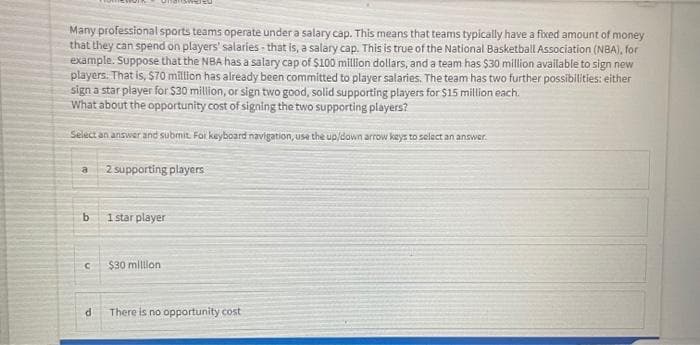Many professional sports teams operate under a salary cap. This means that teams typically have a fixed amount of money that they can spend on players' salaries - that is, a salary cap. This is true of the National Basketball Association (NBA), for example. Suppose that the NBA has a salary cap of $100 millon dollars, and a team has $30 million available to sign new players. That is, $70 million has already been committed to player salaries. The team has two further possibilities: either sign a star player for $30 million, or sign two good, solid supporting players for $15 million each. What about the opportunity cost of signing the two supporting players? Select an answer and submit. For keyboard navigation, use the up/down arrow keys to selact an answer. 2 supporting players 1 star player %$30 millon There is no opportunity cost
Many professional sports teams operate under a salary cap. This means that teams typically have a fixed amount of money that they can spend on players' salaries - that is, a salary cap. This is true of the National Basketball Association (NBA), for example. Suppose that the NBA has a salary cap of $100 millon dollars, and a team has $30 million available to sign new players. That is, $70 million has already been committed to player salaries. The team has two further possibilities: either sign a star player for $30 million, or sign two good, solid supporting players for $15 million each. What about the opportunity cost of signing the two supporting players? Select an answer and submit. For keyboard navigation, use the up/down arrow keys to selact an answer. 2 supporting players 1 star player %$30 millon There is no opportunity cost
Microeconomics: Private and Public Choice (MindTap Course List)
16th Edition
ISBN:9781305506893
Author:James D. Gwartney, Richard L. Stroup, Russell S. Sobel, David A. Macpherson
Publisher:James D. Gwartney, Richard L. Stroup, Russell S. Sobel, David A. Macpherson
Chapter12: The Supply Of And Demand For Productive Resources
Section: Chapter Questions
Problem 7CQ
Related questions
Question
2

Transcribed Image Text:Many professional sports teams operate under a salary cap. This means that teams typically have a fixed amount of money
that they can spend on players' salaries - that is, a salary cap. This is true of the National Basketball Association (NBA), for
example. Suppose that the NBA has a salary cap of $100 million dollars, and a team has $30 million available to sign new
players. That is, $70 million has already been committed to player salaries. The team has two further possibilities: either
sign a star player for $30 million, or sign two good, solid supporting players for $15 million each.
What about the opportunity cost of signing the two supporting players?
Select an answer and submit. For keyboard navigation, use the up/down arrow kays to selact an answer.
2 supporting players
1 star player
$30 milon
There is no opportunity cost
Expert Solution
This question has been solved!
Explore an expertly crafted, step-by-step solution for a thorough understanding of key concepts.
This is a popular solution!
Trending now
This is a popular solution!
Step by step
Solved in 2 steps

Knowledge Booster
Learn more about
Need a deep-dive on the concept behind this application? Look no further. Learn more about this topic, economics and related others by exploring similar questions and additional content below.Recommended textbooks for you

Microeconomics: Private and Public Choice (MindTa…
Economics
ISBN:
9781305506893
Author:
James D. Gwartney, Richard L. Stroup, Russell S. Sobel, David A. Macpherson
Publisher:
Cengage Learning

Economics: Private and Public Choice (MindTap Cou…
Economics
ISBN:
9781305506725
Author:
James D. Gwartney, Richard L. Stroup, Russell S. Sobel, David A. Macpherson
Publisher:
Cengage Learning


Microeconomics: Private and Public Choice (MindTa…
Economics
ISBN:
9781305506893
Author:
James D. Gwartney, Richard L. Stroup, Russell S. Sobel, David A. Macpherson
Publisher:
Cengage Learning

Economics: Private and Public Choice (MindTap Cou…
Economics
ISBN:
9781305506725
Author:
James D. Gwartney, Richard L. Stroup, Russell S. Sobel, David A. Macpherson
Publisher:
Cengage Learning


Exploring Economics
Economics
ISBN:
9781544336329
Author:
Robert L. Sexton
Publisher:
SAGE Publications, Inc